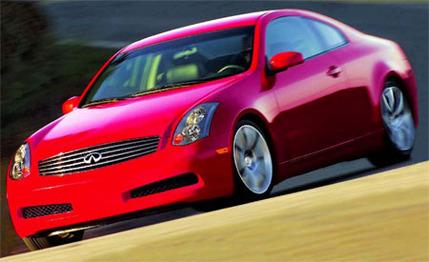
 First Drive Review
First Drive Review
Any resemblance you see between the stylish new Infiniti G35 coupe and Nissan's recently introduced 350Z is not just a coincidence. Under the skin, they're essentially the same car, yet these fraternal twins are expected to play distinct roles for owners whose priorities diverge along some important lines.
As the upscale division of Nissan, Infiniti needed its sportiest model to flaunt some genteel characteristics, provide a greater degree of comfort, and manifest its luxury attributes more intensely. The styling, too, was required to express a voguish elegance rather than the naked muscularity of the 350Z.
But if these were tough problems to overcome, you wouldn't know it. Our early exposure to the new model suggests the company has pretty much nailed it. Many of the writers at the G35's first outing, at the Infineon Raceway (formerly Sears Point International) in Sonoma, California, thought the car better-looking than its Z-badged brother. Certainly, the G35-sedan-derived rear end and taillight treatment are more easily accepted than the contentious planes of the Z-car's derrière.


The wheelbase is longer than the Z-car's by almost eight inches (equal to that of the G35 sedan), and the car itself is 12.6 inches longer (and about 200 pounds heavier). The added length was needed to accommodate the Infiniti's usable rear seats and a larger, eight-cubic-foot trunk (one more than the Z's), which is also mercifully free of the sports car's intrusive shock-tower bridging. In keeping with its somewhat more dignified role, the G35 two-door has had its suspension--otherwise identical to the 350Z's--calibrated to offer a softer ride.
But this is still a car based on chief vehicle engineer Kazutoshi Mizuno's FM (front midship) platform, and remember, Mizuno was head of Nissan's Le Mans and Group C racing programs before he became, well, an FM tuner at the Nissan Technical Center in Japan.
So we were confident the car would feel at home on a racetrack. Apparently, the Japanese engineers wanted to be sure and added oil coolers to the cars we drove, as well as conducting extensive brake tests beforehand. Infineon is a track that calls for pretty heavy brake use, for sure, but the massive Brembo discs and calipers peeking through the 18-inch alloy wheels included on the six-speed manual model looked well up to the task.